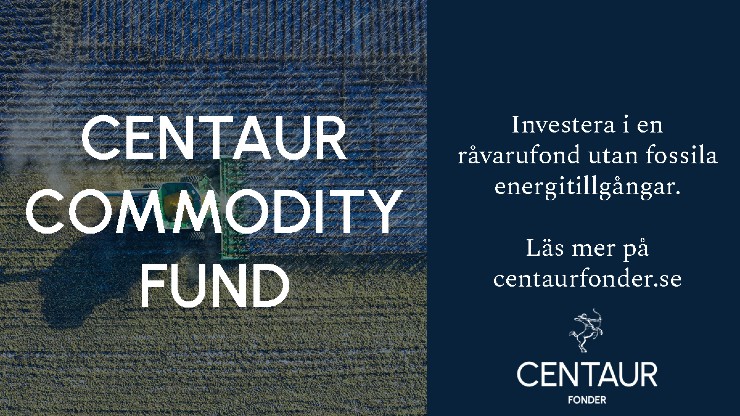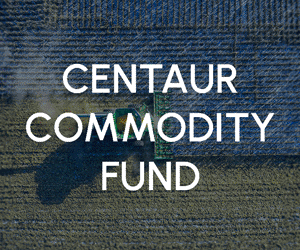Analys
SHB Råvarubrevet 22 oktober 2011
 Vårt Råvaruindex backade med någon procentenhet under veckan men marknaden fann stöd och riskaptiten tilltog efter förhoppningar om att de europeiska ledarna närmar sig en lösning på skuldkrisen samtidigt som Fed indikerade ett möjligt QE3. Kraftigt fall på råoljelagren samtidigt som Libyens oljeproduktion börjar återhämta sig. Gaddafi´s död påskyndar tidsplanen kring oljeproduktionen något men vi tror att uppstart av oljefält och reparationer kommer att ta mycket tid och kraft. Detta bör upprätthålla oljemarknaden något. Statoil meddelade i slutet av veckan att fyndigheten vid Aldus Major South i Nordsjön kan vara en av de största i norsk historia. I övrigt var det kraftiga fall på metaller men marknaderna återhämtade delar av rörelsen mot slutet av veckan.
Vårt Råvaruindex backade med någon procentenhet under veckan men marknaden fann stöd och riskaptiten tilltog efter förhoppningar om att de europeiska ledarna närmar sig en lösning på skuldkrisen samtidigt som Fed indikerade ett möjligt QE3. Kraftigt fall på råoljelagren samtidigt som Libyens oljeproduktion börjar återhämta sig. Gaddafi´s död påskyndar tidsplanen kring oljeproduktionen något men vi tror att uppstart av oljefält och reparationer kommer att ta mycket tid och kraft. Detta bör upprätthålla oljemarknaden något. Statoil meddelade i slutet av veckan att fyndigheten vid Aldus Major South i Nordsjön kan vara en av de största i norsk historia. I övrigt var det kraftiga fall på metaller men marknaderna återhämtade delar av rörelsen mot slutet av veckan.
Det är makroekonomisk oro som styr råvarumarknaden just nu och det är väl ingen överraskning att marknaden förväntar sig mycket långsam tillväxt i Europa, mycket långsam tillväxt i USA och avtagande tillväxt i Kina. Detta har inneburit att en stor del av analytikerkåren har reviderat ned sina prognoser på framför allt metaller. Vi har dock aldrig sett en sådan delad analytikerkår eftersom potentialen för dominoeffekt från enskilda händelser är mycket stor och ökar risken. På Koppar exempelvis pekar prognoserna på allt mellan 7,500 dollar och 10,500 dollar för den kommande 24 månaders perioden.
En hel del osäkerhet och en marknad som anpassat till en kraftig volatilitet kommer naturligtvis bjuda på möjligheter att komma in i råvarumarknaden på gynnsamma nivåer. Det är därför viktigt att belysa en längre placeringshorisont och råvaror ur ett diversifieringsperspektiv. Vi har studerat under vilka perioder sedan 1995 man INTE hade uppnått en lägre risk genom att inkludera råvaror i portföljen. Föga förvånande så har ett inkluderande av råvaror i sparportföljen under samtliga kvartal under denna period lett till en lägre risk. Med andra ord, det har undantagslöst förbättrat den riskjusterade avkastningen, det som är det absolut viktigaste sättet att generera avkastning.
Om vi då ser till det längre perspektivet kan vi inte komma runt det faktum att efterfrågan växer på en ändlig resurs. Om vi väljer att bryta ner vårt råvaruindex i underkomponenter skulle jag se det så här:
1) Ädelmetaller: Guld och silver har stigit kraftigt under nuvarande finanskris, drivet av sin status som värdebevarare i orostider. På kort sikt anser vi att denna våg är över, men att på lägre sikt så utgör ädelmetaller en bra försäkring i en diversifierad sparportfölj.
2) Basmetaller: Dessa höll sig höga långt in i årets börsfall och konjunkturoro, för att nyligen falla 15 % på en vecka. Här anser vi att det både på kort och lång sikt är bra köpläge, Kina och övriga tillväxtmarknader kommer att driva på efterfrågan, och fler aktörer hoppas på prisfall än vad som fruktar detsamma. Faller priset så dras utbud bort från marknaden då utvinning inte blir lönsam.
3) Livsmedel: Även här pekar både konsumtionsmönster och befolkningstillväxt på en ekvation som är svår att få ihop på sikt, fler människor ska äta och fler anammar västerländska konsumtionsmönster vilket leder till högre efterfrågan på kött och protein. Vi hoppas att mer spannmål kan produceras, och framför allt distribueras, till de som behöver, utan att kostnaderna stiger. Men risken är att det bara är högre priser som leder till ökade investeringar i jordbruk och spannmålsproduktion.
4) Energi: Ännu en omöjlig ekvation att lösa, efterfrågan på fossila bränslen stiger trots miljömedvetenhet, och de ”billiga” tillgångarna på råolja utarmas. All ny oljeutvinning sker till betydligt högre kostnader, vilket återspeglas i priset. Oljepriset samvarierar ganska väl med kortsiktiga konjunkturförväntningar, men kommer på sikt inte att kunna gå annat än upp som vi ser det.
Sammanvägt går det inte att dra någon annan slutsats än att råvaror kommer att stiga i pris. Kortsiktigt kommer de att vara fortsatt volatila och riskfyllda, särskilt i dessa finansiella orostider, men på längre sikt kommer de att stiga. Skulle dessutom börsen repa mod under återstoden av året så kommer råvarupriserna att stiga även kortsiktigt.
Handelsbankens Råvaruindex
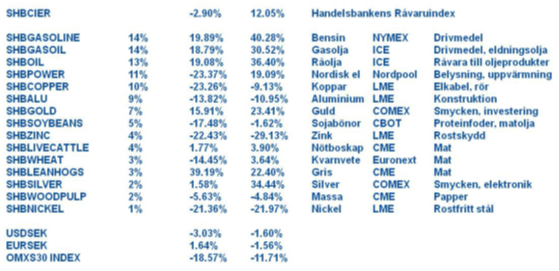
Handelsbankens råvaruindex består av de underliggande indexen för respektive råvara. Vikterna är bestämda till hälften från värdet av global produktion och till hälften från likviditeten i terminskontrakten.
[box]SHB Råvarubrevet är producerat av Handelsbanken och publiceras i samarbete och med tillstånd på Råvarumarknaden.se[/box]
Ansvarsbegränsning
Detta material är producerat av Svenska Handelsbanken AB (publ) i fortsättningen kallad Handelsbanken. De som arbetar med innehållet är inte analytiker och materialet är inte oberoende investeringsanalys. Innehållet är uteslutande avsett för kunder i Sverige. Syftet är att ge en allmän information till Handelsbankens kunder och utgör inte ett personligt investeringsråd eller en personlig rekommendation. Informationen ska inte ensamt utgöra underlag för investeringsbeslut. Kunder bör inhämta råd från sina rådgivare och basera sina investeringsbeslut utifrån egen erfarenhet.
Informationen i materialet kan ändras och också avvika från de åsikter som uttrycks i oberoende investeringsanalyser från Handelsbanken. Informationen grundar sig på allmänt tillgänglig information och är hämtad från källor som bedöms som tillförlitliga, men riktigheten kan inte garanteras och informationen kan vara ofullständig eller nedkortad. Ingen del av förslaget får reproduceras eller distribueras till någon annan person utan att Handelsbanken dessförinnan lämnat sitt skriftliga medgivande. Handelsbanken ansvarar inte för att materialet används på ett sätt som strider mot förbudet mot vidarebefordran eller offentliggörs i strid med bankens regler.
Finansiellt instruments historiska avkastning är inte en garanti för framtida avkastning. Värdet på finansiella instrument kan både öka och minska och det är inte säkert att du får tillbaka hela det investerade kapitalet.
Analys
Tightening fundamentals – bullish inventories from DOE

The latest weekly report from the US DOE showed a substantial drawdown across key petroleum categories, adding more upside potential to the fundamental picture.

Commercial crude inventories (excl. SPR) fell by 5.8 million barrels, bringing total inventories down to 415.1 million barrels. Now sitting 11% below the five-year seasonal norm and placed in the lowest 2015-2022 range (see picture below).
Product inventories also tightened further last week. Gasoline inventories declined by 2.1 million barrels, with reductions seen in both finished gasoline and blending components. Current gasoline levels are about 3% below the five-year average for this time of year.
Among products, the most notable move came in diesel, where inventories dropped by almost 4.1 million barrels, deepening the deficit to around 20% below seasonal norms – continuing to underscore the persistent supply tightness in diesel markets.
The only area of inventory growth was in propane/propylene, which posted a significant 5.1-million-barrel build and now stands 9% above the five-year average.
Total commercial petroleum inventories (crude plus refined products) declined by 4.2 million barrels on the week, reinforcing the overall tightening of US crude and products.
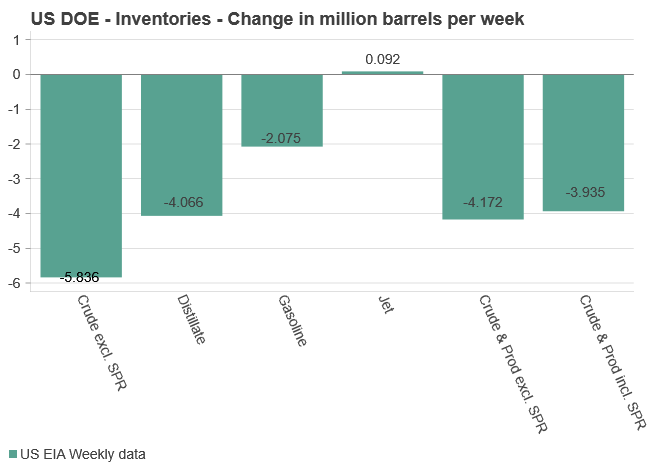
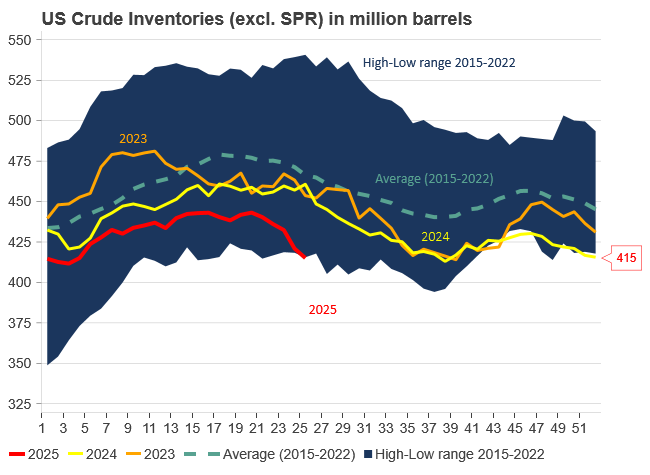
Analys
Bombs to ”ceasefire” in hours – Brent below $70

A classic case of “buy the rumor, sell the news” played out in oil markets, as Brent crude has dropped sharply – down nearly USD 10 per barrel since yesterday evening – following Iran’s retaliatory strike on a U.S. air base in Qatar. The immediate reaction was: “That was it?” The strike followed a carefully calibrated, non-escalatory playbook, avoiding direct threats to energy infrastructure or disruption of shipping through the Strait of Hormuz – thus calming worst-case fears.

After Monday morning’s sharp spike to USD 81.4 per barrel, triggered by the U.S. bombing of Iranian nuclear facilities, oil prices drifted sideways in anticipation of a potential Iranian response. That response came with advance warning and caused limited physical damage. Early this morning, both the U.S. President and Iranian state media announced a ceasefire, effectively placing a lid on the immediate conflict risk – at least for now.
As a result, Brent crude has now fallen by a total of USD 12 from Monday’s peak, currently trading around USD 69 per barrel.
Looking beyond geopolitics, the market will now shift its focus to the upcoming OPEC+ meeting in early July. Saudi Arabia’s decision to increase output earlier this year – despite falling prices – has drawn renewed attention considering recent developments. Some suggest this was a response to U.S. pressure to offset potential Iranian supply losses.
However, consensus is that the move was driven more by internal OPEC+ dynamics. After years of curbing production to support prices, Riyadh had grown frustrated with quota-busting by several members (notably Kazakhstan). With Saudi Arabia cutting up to 2 million barrels per day – roughly 2% of global supply – returns were diminishing, and the risk of losing market share was rising. The production increase is widely seen as an effort to reassert leadership and restore discipline within the group.
That said, the FT recently stated that, the Saudis remain wary of past missteps. In 2018, Riyadh ramped up output at Trump’s request ahead of Iran sanctions, only to see prices collapse when the U.S. granted broad waivers – triggering oversupply. Officials have reportedly made it clear they don’t intend to repeat that mistake.
The recent visit by President Trump to Saudi Arabia, which included agreements on AI, defense, and nuclear cooperation, suggests a broader strategic alignment. This has fueled speculation about a quiet “pump-for-politics” deal behind recent production moves.
Looking ahead, oil prices have now retraced the entire rally sparked by the June 13 Israel–Iran escalation. This retreat provides more political and policy space for both the U.S. and Saudi Arabia. Specifically, it makes it easier for Riyadh to scale back its three recent production hikes of 411,000 barrels each, potentially returning to more moderate increases of 137,000 barrels for August and September.
In short: with no major loss of Iranian supply to the market, OPEC+ – led by Saudi Arabia – no longer needs to compensate for a disruption that hasn’t materialized, especially not to please the U.S. at the cost of its own market strategy. As the Saudis themselves have signaled, they are unlikely to repeat previous mistakes.
Conclusion: With Brent now in the high USD 60s, buying oil looks fundamentally justified. The geopolitical premium has deflated, but tensions between Israel and Iran remain unresolved – and the risk of missteps and renewed escalation still lingers. In fact, even this morning, reports have emerged of renewed missile fire despite the declared “truce.” The path forward may be calmer – but it is far from stable.
Analys
A muted price reaction. Market looks relaxed, but it is still on edge waiting for what Iran will do

Brent crossed the 80-line this morning but quickly fell back assigning limited probability for Iran choosing to close the Strait of Hormuz. Brent traded in a range of USD 70.56 – 79.04/b last week as the market fluctuated between ”Iran wants a deal” and ”US is about to attack Iran”. At the end of the week though, Donald Trump managed to convince markets (and probably also Iran) that he would make a decision within two weeks. I.e. no imminent attack. Previously when when he has talked about ”making a decision within two weeks” he has often ended up doing nothing in the end. The oil market relaxed as a result and the week ended at USD 77.01/b which is just USD 6/b above the year to date average of USD 71/b.

Brent jumped to USD 81.4/b this morning, the highest since mid-January, but then quickly fell back to a current price of USD 78.2/b which is only up 1.5% versus the close on Friday. As such the market is pricing a fairly low probability that Iran will actually close the Strait of Hormuz. Probably because it will hurt Iranian oil exports as well as the global oil market.
It was however all smoke and mirrors. Deception. The US attacked Iran on Saturday. The attack involved 125 warplanes, submarines and surface warships and 14 bunker buster bombs were dropped on Iranian nuclear sites including Fordow, Natanz and Isfahan. In response the Iranian Parliament voted in support of closing the Strait of Hormuz where some 17 mb of crude and products is transported to the global market every day plus significant volumes of LNG. This is however merely an advise to the Supreme leader Ayatollah Ali Khamenei and the Supreme National Security Council which sits with the final and actual decision.
No supply of oil is lost yet. It is about the risk of Iran closing the Strait of Hormuz or not. So far not a single drop of oil supply has been lost to the global market. The price at the moment is all about the assessed risk of loss of supply. Will Iran choose to choke of the Strait of Hormuz or not? That is the big question. It would be painful for US consumers, for Donald Trump’s voter base, for the global economy but also for Iran and its population which relies on oil exports and income from selling oil out of that Strait as well. As such it is not a no-brainer choice for Iran to close the Strait for oil exports. And looking at the il price this morning it is clear that the oil market doesn’t assign a very high probability of it happening. It is however probably well within the capability of Iran to close the Strait off with rockets, mines, air-drones and possibly sea-drones. Just look at how Ukraine has been able to control and damage the Russian Black Sea fleet.
What to do about the highly enriched uranium which has gone missing? While the US and Israel can celebrate their destruction of Iranian nuclear facilities they are also scratching their heads over what to do with the lost Iranian nuclear material. Iran had 408 kg of highly enriched uranium (IAEA). Almost weapons grade. Enough for some 10 nuclear warheads. It seems to have been transported out of Fordow before the attack this weekend.
The market is still on edge. USD 80-something/b seems sensible while we wait. The oil market reaction to this weekend’s events is very muted so far. The market is still on edge awaiting what Iran will do. Because Iran will do something. But what and when? An oil price of 80-something seems like a sensible level until something do happen.
-

 Nyheter3 veckor sedan
Nyheter3 veckor sedanStor uppsida i Lappland Guldprospekterings aktie enligt analys
-

 Nyheter4 veckor sedan
Nyheter4 veckor sedanBrookfield ska bygga ett AI-datacenter på hela 750 MW i Strängnäs
-

 Nyheter3 veckor sedan
Nyheter3 veckor sedanSilverpriset släpar efter guldets utveckling, har mer uppsida
-

 Nyheter4 veckor sedan
Nyheter4 veckor sedanTradingfirman XTX Markets bygger datacenter i finska Kajana för 1 miljard euro
-

 Nyheter2 veckor sedan
Nyheter2 veckor sedanUppgången i oljepriset planade ut under helgen
-

 Nyheter2 veckor sedan
Nyheter2 veckor sedanLåga elpriser i sommar – men mellersta Sverige får en ökning
-

 Analys2 veckor sedan
Analys2 veckor sedanVery relaxed at USD 75/b. Risk barometer will likely fluctuate to higher levels with Brent into the 80ies or higher coming 2-3 weeks
-

 Nyheter1 vecka sedan
Nyheter1 vecka sedanMahvie Minerals växlar spår – satsar fullt ut på guld



